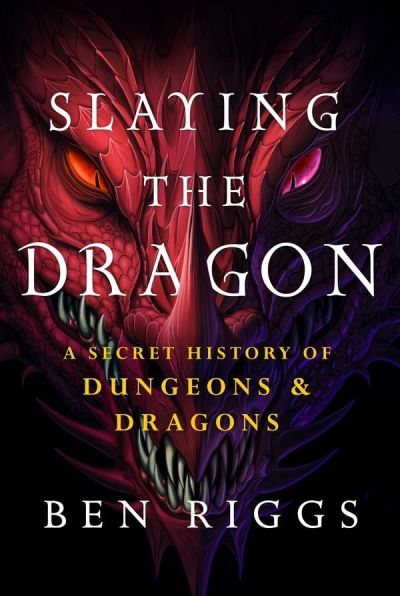Wonder In Most Every Thing I See
Slaying the Dragon: A Secret History of Dungeons & Dragons
By Ben Riggs

4 Aug, 2022
0 comments
Ben Riggs’ 2022 Slaying the Dragon: A Secret History of Dungeons & Dragons is an account of the rise and fall of TSR, publisher of Dungeons & Dragons, as well as many related works.
Although there were precursors to table-top roleplaying games (including the Bronte siblings’ 19th century foreshadowingof the pastime), Dungeons and Dragons is generally acknowledged as the first modern roleplaying game. Having founded the field, publisher TSR dominated sales. Roleplaying fans and game merchants, therefore, were taken aback when in the mid-1990s TSR suddenly imploded. Only timely intervention by cash-rich Wizards of the Coast gave the game a new owner and new lease on life.
Perhaps the chief question addressed is “What went wrong?”
Having read the book, perhaps a better question is “how did nemesis take so long to catch up with TSR?”
The narrative is recounted in an informal, almost colloquial style.
With 304 pages to cover a quarter century of history, the text is necessarily rather compressed. For example, Gygax is transformed from married to divorced without mention of the actual divorce, and minor figures like Trampier are omitted entirely. The focus is very much on TSR, with other companies generally only mentioned as their activities impinged on TSR. Consequently, there’s a lot of big-picture background about the RPG industry that falls outside the scope of the work.
Having discovered that the standard account of TSR’s rise and fall was incomplete, Riggs set out to interview as many of the participants as were still alive and willing to talk to him. Certain perspectives are therefore missing. Editor Brian Thomsen, for example, died in 2008 and was not available. Lorraine Williams was unwilling to revisit that chapter of her life. Their views, therefore, must be the subject of speculation. Riggs sets out what he thinks happened, while making clear that there are areas of dispute and happenings that lack clarity.
Well, this was a stroll down memory lane. Having gamed since 1980 and been involved in the industry at various levels since 1982, I was aware of these events only from the perspective of an outsider; much of what I thought to be true turns out to be fabulation based on rumor. Thanks to Riggs’s work, I now have a more accurate view of what happened back then.
Slaying the Dragon is available here (Amazon US), here (Amazon Canada), here (Amazon UK), here (Barnes & Noble), here (Book Depository), and here (Chapters-Indigo).
If you’d like to read a deeper dive, here’s a chapter-by-chapter synopsis.
PART I: The rise and fall of Gary Gygax
This section covers the synergistic creation of Dungeons & Dragons from Dave Arneson’s Blackmoor and E. Gary Gygax’s Chainmail miniature rules [1]. Thence to the founding of TSR, the sudden elevation of Gygax from pauper to rich man, and … is there a nice way to say “self-indulgent nepotistic cocaine-fueled lunacy”? … the bold management decisions that followed. Thanks to the visionary managerial insight of such figures as Gygax and business associates the Blume Brothers, TSR was brought to the brink of insolvency.
Brought on board as a funding source, Lorraine Williams out-maneuvered Gygax. Williams took command, and Gygax was forced out.
PART II: The Williams era
Having deposed Gygax, Williams tried to transform TSR into a reliable profit source. While she had a fair amount of success, market shifts, contractual obligations, and … is there a nice way to say “a culture of creative-alienating paranoid authoritarianism”? … a memorable management style undermined the company.
PART III: Slapping a band-aid on failures
Stratagems intended to address the company’s issues either failed or made matters worse. In the end, TSR, overwhelmed by debt and unable to provide product to stores, ground to a halt. Doom was certain.
PART IV: The Preacher’s son performs a resurrection
Wizards of the Coast was cash-flush and interested in buying TSR. However, Lorraine Williams loathed WOTC and was unwilling to sell. A third party intervened, and D&D was saved.
1: Rules pertaining to the use of small figurines in games, not rules which were themselves very small.
